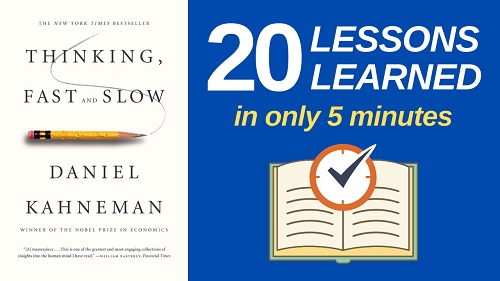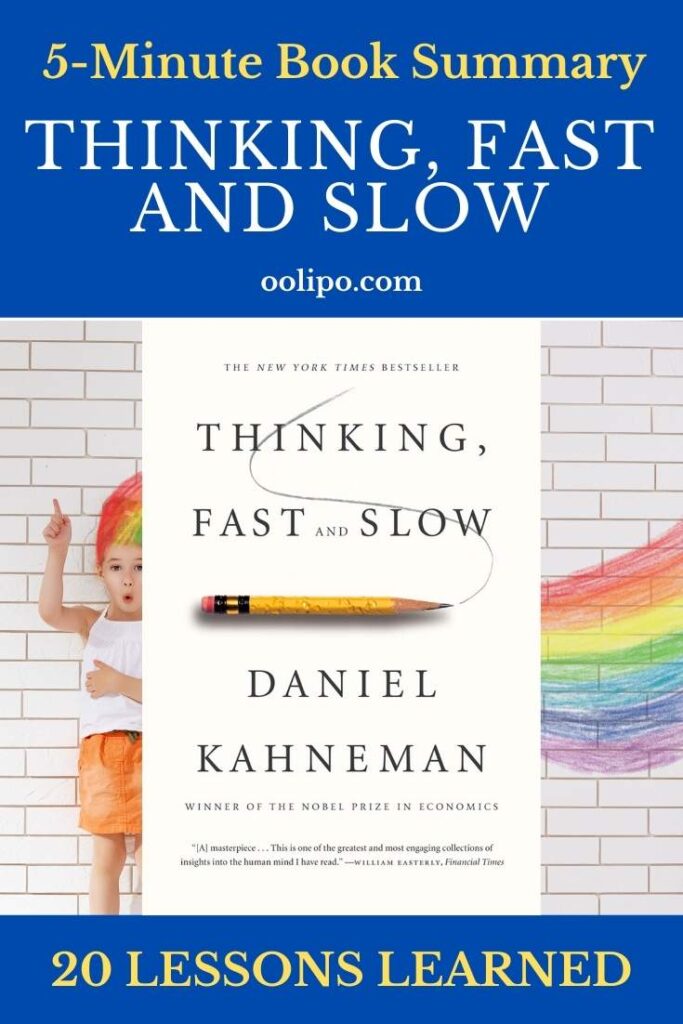Thinking, Fast and Slow is a 2012 book written by Daniel Kahneman. In this Thinking, Fast and Slow summary, we dive deep into Kahneman’s perspective on making better decisions and arranging tasks more efficiently.
Thinking and making decisions are often automatic tasks. Sometimes we can decide in an instant, and sometimes we cannot decide for hours. Is it really so or is our brain deceiving us? Nobel Prize-winning author Daniel Kahneman has collected his research on how we think and decide in this book.

Thinking, Fast and Slow Summary with 20 Lessons Learned
Here are the 20 lessons to learn from Thinking, Fast and Slow Summary:
#1 Intuition and Logic
The book talks about our two decision-making mechanisms based on intuition and logic. While making a decision, we either rely on previous knowledge and experience, or we examine the current data and try to make a more logical decision.
#2 Intuitive Decisions
We make the decisions that get us in the most trouble and frustrate us with our intuition. This is the reason for our momentary emotional reactions and prejudices. Its advantage is that it enables us to make quick decisions.
#3 Logical Decisions
They are decisions that are taken after adequate reflection on a subject despite our prejudices and feelings. It is slow, but before we act, the share of the decision we make will increase greatly. We gain different perspectives on the issue we need to decide.
#4 Fears
People tend to get away from negative situations right away. That’s why we need to make more intuitive decisions when there is a loss or a situation that will frighten us. Because we want to quickly leave that environment or change the situation we are in.
#5 Confidence
Although self-confidence is something to be proud of and desired, too much of it drives us into the abyss. The more confident we are in ourselves, the faster we make decisions. We act without fully understanding the issue, and it can end in disaster. We know that a few executives who take excessive risks have inflicted huge losses on their companies.
#6 Monotonous Lives
Even if you are the most logical person in the world, you spend most of your day making intuitive decisions. To make logical decisions, you have to experience different things during the day. Life would be very slow if we didn’t have intuitive decision-making. No job would be enough.
#7 Evidence
While a lot of evidence is needed to make logical decisions, a few tips are enough to make intuitive decisions. In cases where we try to conclude immediately, our brain produces a scenario related to the subject and proceeds on this scenario.
#8 Thinking Slow
We can consciously slow down our thoughts that do not slow down until we encounter an unexpected situation. If you don’t condition yourself on this from time to time, you can spend most of your life making snap decisions. This can affect your life negatively as it will not be the right decision in general.
#9 Right Decisions
Our brain is very prone to deception. Moreover, even though he is deceived, he does not want to believe it and looks for an outlet to see that he is right. We must make an effort to make rational decisions. Once we have made an intuitive decision and this decision has been wrong, our brain may even prefer to deceive itself instead of making a logical decision.
#10 Realizing We Made the Wrong Decision
We make countless decisions throughout our lives. Many of these decisions are unlikely to be correct. The worst part is that we do not realize that our decisions are wrong. The book shows how far people can live without awareness with previous tests.
#11 Others Mistakes
Although we make countless mistakes with the decisions we make ourselves, we find it difficult to notice them, but we are much more successful at seeing the mistakes of others. We should look at our actions as if we were looking at the actions of others. We must learn to manage our prejudices.
#12 Generalizations
We form prejudices about people by looking at a mistake or a right thing they do. We have a prejudice that people who are successful at one thing will be successful at another, or that the person we see making mistakes is generally incompetent. We think of events as if they are related to each other.
#13 Decision-Making Formulas
Making decisions based on calculations and formulas rather than with our ideas can help us to be much more successful. Decision-making formulas can be drawn within each subject and can be acted upon accordingly. The less we use our intuition, the better things go.
#14 Familiarity
All humanity tends to choose what is familiar if a decision has to be made. It is to this that we can live our lives much faster in general. Because we don’t have a chance to test all the options one by one.
#15 Intelligence Deceives
No matter how smart and hardworking a person is, he is always affected by his prejudices. Even if you think for a long time before making a decision, the decision you make can often be the logical reason for your intuitive decision.
#16 Habit
When you’re in a unique situation, starting to think slowly only works the first time. As you experience the same event on subsequent trips, you now have a prejudice. This bias causes you to make intuitive decisions again. So we come back every time.
#17 Details
We don’t realize it when minor differences occur in familiar events. These small differences accumulate over time and we start to think about when this change happened. From time to time, we should ask ourselves questions, even when we are faced with issues that we are very confident about.
#18 The Chance of Being Wrong
As mentioned earlier in this Thinking, Fast and Slow Summary, we must remind ourselves that we can err on even the simplest things or the things we know best. Our continuity in making the right decision depends a little bit on our self-doubt. We know that we are not likely to be right about everything, but we forget that.
#19 Too Much Doubt
Just as too much self-confidence is harmful, too much doubt is harmful. The part that needs attention is balance. Approaching everything with suspicion makes us inactive. We must train our minds to make wise decisions without fear.
#20 Speed of Thought
A child, a flower, a book, a car… The moment you encounter something, your brain has already prepared its reaction before you realize it. As soon as you feel like giving that reaction, you can stop and think for a second, and now you’re in control. Your decision-making is delegated from intuition to logic.
Top 10 Quotes from Thinking, Fast and Slow
1. “You experienced slow thinking as you proceeded through a sequence of steps. You first retrieved from memory the cognitive program for multiplication that you learned in school, then you implemented it.”
2. “Everyone has some awareness of the limited capacity of attention, and our social behavior makes allowances for these limitations. When the driver of a car is overtaking a truck on a narrow road, for example, adult passengers quite sensibly stop talking.”
3. “The sophisticated allocation of attention has been honed by a long evolutionary history. Orienting and responding quickly to the gravest threats or most promising opportunities improved the chance of survival, and this capability is certainly not restricted to humans.”
4. “As you become skilled in a task, its demand for energy diminishes. Studies of the brain have shown that the pattern of activity associated with an action changes as skill increases, with fewer brain regions involved.”
5. “Your probability that it will rain tomorrow is your subjective degree of belief, but you should not let yourself believe whatever comes to your mind. To be useful, your beliefs should be constrained by the logic of probability”
6. “Students who do not develop a new appreciation for the power of social setting have learned nothing of value from the experiment.”
7. “You can get a good conversation started at a party by asking for an explanation, and your friends will readily oblige. Even people who have had some exposure to statistics will spontaneously interpret the statement in causal terms.”
8. “Some predictive judgments, such as those made by engineers, rely largely on look-up tables, precise calculations, and explicit analyses of outcomes observed on similar occasions”
9. “Our emotional state is largely determined by what we attend to, and we are normally focused on our current activity and immediate environment.”
10. “Imaginability plays an important role in the evaluation of probabilities in real-life situations. The risk involved in an adventurous expedition, for example, is evaluated by imagining contingencies with which the expedition is not equipped to cope.”
Free PDF Download of Thinking, Fast and Slow Summary to Save or Print
We created a PDF file with the summary and quotes on this page for easy access: Download Thinking, Fast and Slow PDF Summary. If you want to buy the paperback version of the book, check out this page.
Daniel Kahneman on How to Think Fast and Slow
The Popular Daniel Kahneman Ted Talk
Please share these important lessons by pinning this post to Pinterest.
